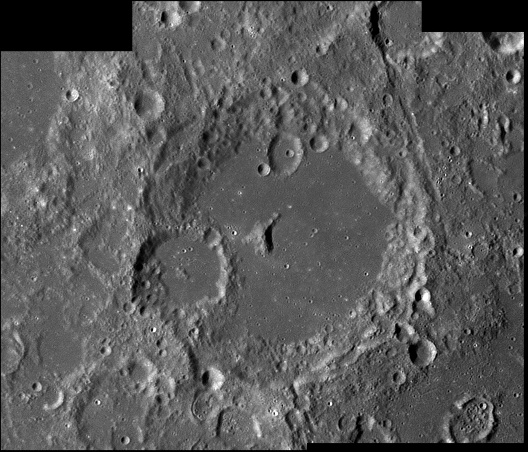 Click for full size image.
Click for full size image.Lunar Imagery in 2009
By Damian Peach.
Overall, whilst being a productive year for the major Planets, the Moon very much took a back seat after the huge amount of work completed in photographing the Lunar surface over the last five years. The major lunar work completed was my involvement in the record break mosaic in April, though the only high resolution images taken were in September, some of which are presented below.
Albategnius. A large impact crater located in the central highlands. It is heavily worn indicating its great age (3 billion years.) It features in one of Galileos earliest drawings in 1610 when he sketched the lunar terminator. 2009/09/09. C14 & SKYnyx 2.0M.
Aristarchus. The brightest of the major lunar features, it can be seen as a bright spot with the naked eye. The reason the crater appears so bright is due to its relatively young age of around 450 million years. This view obtained with the Sun high in the sky reveals clearly the ejecta blanket surrounding the crater. 2009/09/09. C14 & SKYnyx 2.0M.
Copernicus Sunrise. One of the most prominent and spectacular of all lunar craters. It is 93km wide, and was formed around 800 million years ago. This view was obtained with the crater just emerging from the terminator. The spectacular view through the eyepiece prompted the only lunar image of this particular night. 2009/08/29. C14 & SKYnyx 2.0M.
Drygalski. This rarely seen large crater along the extreme southern limb of the Moon can only be well seen during favourable librations. It is 149km in diameter. 2009/09/09. C14 & SKYnyx 2.0M.
Hausen. Another rarely seen crater located along the extreme SW limb of the Moon, only seen during favourable libration. It is 167km in diameter and is located on the edge of the giant Bailly crater. 2009/09/09. C14 & SKYnyx 2.0M.
Moretus in colour. This view of the well known Moretus crater in the southern highlands was obtained through red, green and blue filters as an experimental true colour high resolution image. It is interesting to note the tones and very subtle colour that is present which typical mono imagery misses out on. 2009/09/09. C14 & SKYnyx 2.0M. RGB filters.
The Eastern Sea. Mare Orientale is a huge impact basin 327km in diameter located on the extreme western limb of the Moon as seen from Earth. It can only be seen during favourable librations (such as occurred in the view above.) When seen from above it well resembles a bulls eye pattern, with two mountain ranges (Montes Rook and Cordillera) surrounding the dark Mare itself both of which are nicely seen in this view. 2009/09/09. C14 & SKYnyx 2.0M.
Reiner Gamma & Surroundings. One of the most peculiar albedo features on the lunar surface. It is thought to be the result of seismic energies generated during the formation of the Mare. It has a strong localised magnetic field which helps to protect the feature from erosion by the solar wind. 2009/09/09. C14 & SKYnyx 2.0M.
Taruntius. This small but interesting crater lays on the north west edge of the Mare Fecunditatis. It is 56km in diameter. It is one of a type of lunar craters known as fractured floor craters. 2009/09/09. C14 & SKYnyx 2.0M.
Rimae Triesnecker. To the east of the crater Triesnecker (26km diameter) is the extensive rille system of the Rimae Triesnecker. These are thought to have been formed from tectonic forces beneath the surface. They extened roughly 200km in length. 2009/09/09. C14 & SKYnyx 2.0M.
A wider view of Tycho. One of the most famour of all lunar craters, tycho is always a pleasure to see. At 108 million years old it is a young crater by lunar standards, hence its freshly cut appearance compared to all the worn craters that surround it. It has an extensive system of impact rays extending more than 1000km from the crater itself. 2009/09/09. C14 & SKYnyx 2.0M.
© All images copyright Damian Peach. No images used on this page may be used. amended, or distributed without the consent of the author.